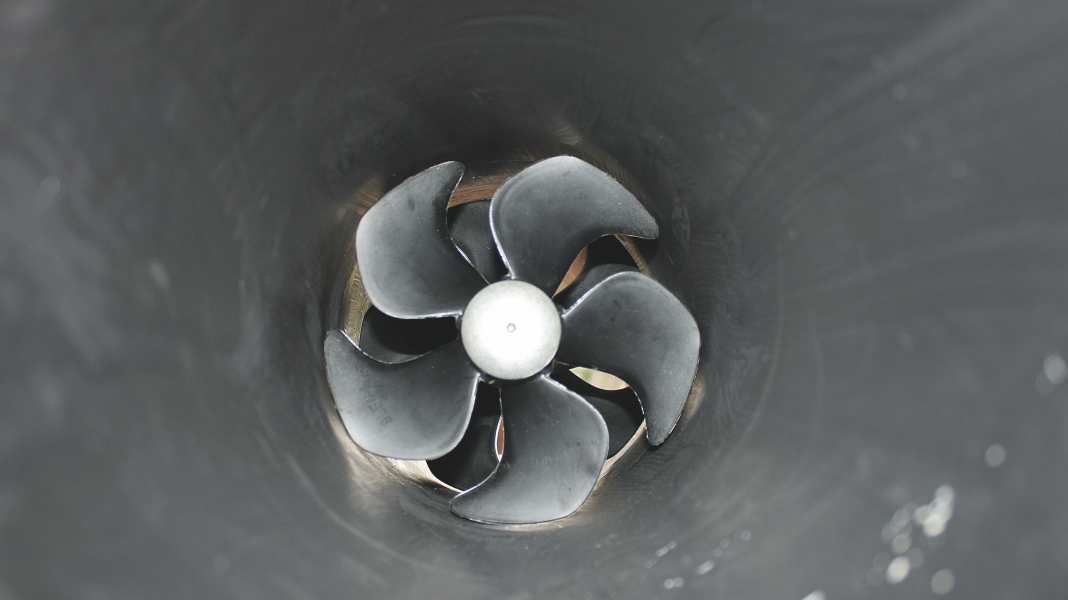
That bow thruster gives the skippermake life easieris well known. But it is also known that conventional bow thrusters are notorious as "wheel robbers". Anyone who passes through a lock with many pleasure craft during the high season knows what we are talking about: everywhereNasty sounding, metallic buzzing noises. If the sound waves are then reflected by the smooth lock walls, it is not only sensitive people who feel disturbed.
But the cause is not where you might think it is. It is not the engines that make the noise, but the propellers. Rotating at high speed in a narrow tunnel, the whirl can't help but cavitate. The result:
The cavitation noises, i.e.the million-fold implosion of tiny air bubbles under water, are transferred to the hull, which in turn amplifies the effect like an oversized guitar body.The panic orchestra is ready.
In addition to noise generation, there are alsoanother disadvantage permanently high-speed running bow thruster: As the speed cannot be regulated, the small manoeuvring helper braces itself against wind, current and its own boat weight with all the force at its disposal at the slightest push of a button in the control position.






However, this is often completely unnecessary: In most cases, all it takes is a little "push" in the right direction and the boat does what it should. Instead, the bow whisk likes to suck inhundreds of amperes through cables as thick as a thumb from the (hopefully sufficiently dimensioned) batteries to move the boat a few decimetres from port to starboard or vice versa.
Since he understandablywarms up quicklymanufacturers limit the permitted operating time, i.e. the duty cycle (ED), to a few per cent by means of a note in the manual or, in the best case, an electronic switch-off device, which in practice corresponds to a few seconds of running time. If you ignore this and use the bow thrusterAbused as "endurance runnerswill have to reckon with a new purchase after just a few years.
The manufacturers of bow thrusters are also aware that these conditions are not ideal. For this reason, the Norwegian manufacturer Side-Power has been offering bow thrusters with so-called proportional control (DC Speed Control) for some time now. In contrast to conventional bow thrusters, they work with a continuously variable speed.
In plain language: the more pressure on the button, the more lateral thrust the engine develops. The skipper can therefore adjust the thrust to the manoeuvring requirements. In principle, such a system consists of the actual motor with gearbox, a control unit (the DC controller), an electrically remote-controlled main fuse and the control unit in the control stand.
In the centrepiece, the DC controller, the engine speed is controlled according to the commands from the driver's cab. The "command transmission" takes place via an electronic bus system, a CAN bus, which Side-
Power is called S-Link. The controller controls theDuty cycle increased from around 6 % to up to 50.
This is neat and in practice brings a considerableSecurity gain. But what about the practicality of this technology? To answer this question, we had a Side-Power SE 80/185 T with a DC speed control unit installed in an older Ancora 41 of around 12.5 metres in length. We carried out the installation in the BOOTE issues 5/2016 and 7/2016 described.
At the control stand, the difference between the standard and proportional bow thrusters is initially noticeable through a modified control element. In addition to the actual control lever, which can be moved steplessly from left to right, there are also the so-called hold buttons and a display on which the current thrust, battery status and remaining running time as well as the engine temperature can be shown.
The hold buttons allow the bow thruster to run continuously at a previously set speed. This function is particularly useful when mooring or in locks, as you can leave the helm for a short time - for example to tie up a line - while the bow thruster remains in operation and holds the boat in place.
However, the biggest difference is noticeable when mooring and casting off and when manoeuvring in narrow harbours. Just a gentle push on the control lever is enough to switch the bow thruster on almost silently.
The finely adjustable speed enables smooth manoeuvres without making any noise; your neighbours on the jetty will thank you, especially in the evening or early morning hours. Only when you move the lever to the full load position - which is hardly ever necessary in practice - does the quiet whispering from the foredeck mutate into the familiar "buzzing" and remind us of the cavitation in the propeller tunnel mentioned at the beginning.
Speaking of propellers: The Side-Power SE 80 is equipped with two propellers that increase efficiency and reliably bring the approximately 5 kW of the electric motor into the water. This results in a maximum thrust of around 950 N (96 kg) with a current consumption of 260 A in 24 V electrical systems.
Owners of older bow thrusters may be interested to know that almost every bow thruster from this manufacturer and many models from other manufacturers can be retrofitted with the side power DC controller.We tested the Side-Power SE 80 for a season under a wide range of practical conditions and can summarise by saying that the new proportional technology brings real advantages and, above all, peace and quiet to the boat compared to traditional bow thrusters.
It should also be mentioned that more sophisticated technology is always associated with higher prices. In the case of the device we tested, the total price including bow thruster, tunnel, DC controller, control panel, data bus and mounting material was around 6300 euros. That is around 3400 euros more than for the standard version.

